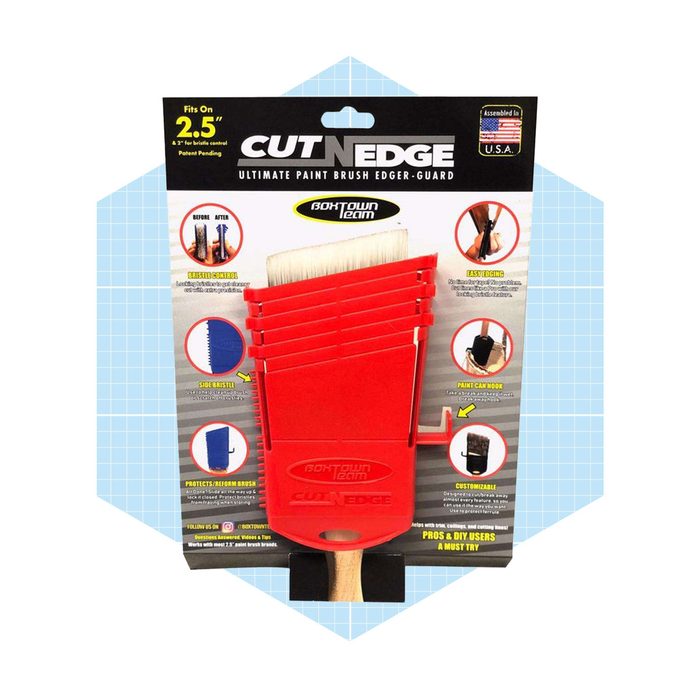 via merchant
via merchant
Simply put, paint pads are thin sponges on a plastic handle. They make excellent paint edging tools for novices who may be intimidated by the notion of cutting in edge paint. Luigi’s self-proclaimed “World’s Best Paint Pad” leaves no brush marks, so the edging paint blends well with roller-applied wall paint.
They make it easy to apply an even coat, and with just a bit of lip that extends past the pad edge, they have a very good line of sight to your trim line. This set also stands out for its variety of sizes and angles. Chances are good that no matter what kind of profile you need to paint, one of these pads will be able to tackle it.
Pros
- Leaves no brush marks
- For indoor or outdoor use
- Includes paint tray
Cons
- Sponges hold less paint and require more frequent refilling
- Not as durable as brushes
 via merchant
via merchant
We’ve mostly talked about tools to help apply paint. But another strategy for quality edging is to protect the trim or edge wall before painting with painter’s tape. If you opt for that method, it’s worth picking up the 3M Hand-Masker Dispenser. This paint edging tool allows you to put down tape faster and more accurately than you could by eyeballing the straightness on your own.
The 3M Hand-Masker is made to be used with Scotch Blue Painter’s Tape (which is excellent!), but it’s compatible with most brands of painter’s tape, too. It can also be used with hand-masker film, a wider protective material often used when spray painting.
Pros
- Speeds up taping
- Helps you lay tape straight the first time
- Works with most brands of painters tape, so you aren’t limited to 3M branded products
- Easy-grip handle
- Protects a variety of surfaces
Cons
- Works best for straight lines, so not ideal for slightly tilted surfaces or irregular lengths of trim
- Pricey
What to Consider When Buying Paint Edging Tools
When buying paint edging tools, it’s important to consider the following:
Quality Construction: Look for paint edging tools that are well-built and made from durable materials without going overboard on weight. This is especially true for rollers or trim tools that you’ll be using overhead.
Cleanup: Once you’re done using the tool, how long will you spend trying to get it clean? A tool that saves an hour of work but takes an extra 40 minutes to clean isn’t much of a deal. (The exception being disposable tools.)
Line of Sight: When laying down an edge line, it’s vital that you can see where the paint is going. Poorly designed tools block your line of sight to the brush (or roller) and the flat edge you’re working against.
Types of Paint Edging Tools
- Trim Brushes: These are paint brushes with bristles cut on an angle, so you’re able to get right up to the edge.
- Paint Guard: This tool has a thin metal edge with a handle, and the precise blade can save you a lot of time.
- Narrow Trim Brushes: The bristles on this brush come to a point, allowing you to get into tight or awkward spots.
- Paint Pads: Paint pads are essentially thin sponges on a plastic handle.
- Paint Edgers: This edge painter tool is a woven-fiber pad with a pair of wheels on one side.
- Rollers: An edging roller is a miniature version of what you use for the wall body paint.
How We Chose the Best Paint Edging Tools
As shopping experts, our only job is to help you find a winning product. We start with the research and reporting basics—what products are made of, what they look like and how much they cost—to ensure that we’re only recommending the buys that are worth your time and money. Then, we research the features that speak to the product’s quality, taking advice from industry insiders and subject matter experts on what makes a product a smart value (or worthy of a splurge). Finally, we do the work of combing through user reviews to see how real people interact with the product, and if it stands up to the test.
FAQ
Do paint edgers actually work?
Yes, if you use them carefully. Paint edging tools eliminate the need for taping along surfaces. Putting down painter’s tape takes a lot of time, and can pull up bits of paint when you remove it. Edging brushes and tools also help you get clean edges around circular objects like smoke detectors.
Can you edge one day and paint the next?
That can be risky. Letting paint dry overnight and finishing the next day can lead to different shades. For the best results, paint the edges first, then paint the rest of the wall with a roller.
How do you fix messy edges when painting?
Wait for it to dry, then use sandpaper to get rid of the messy spot before you touch it up.









